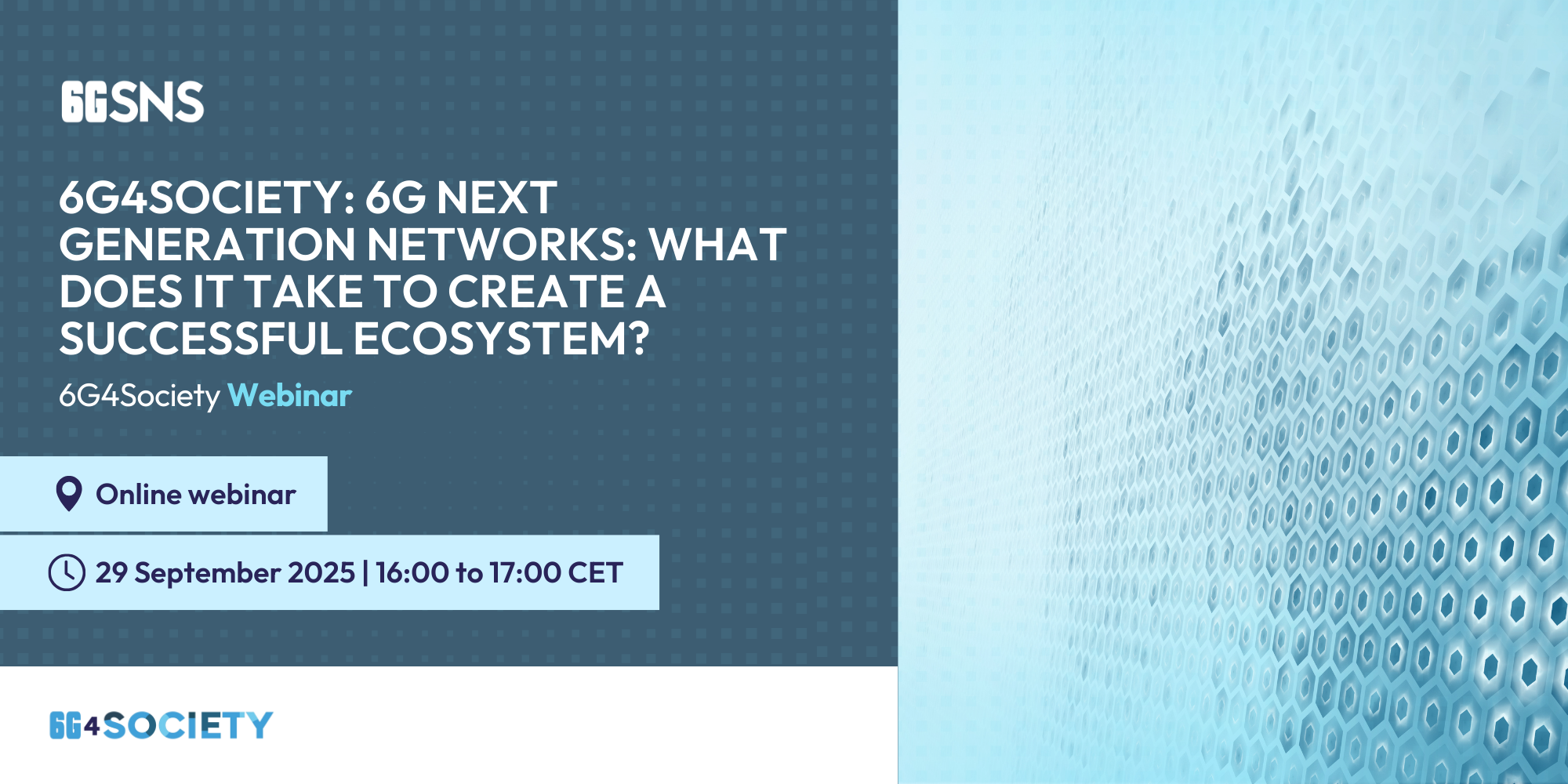6G4Society and 6G Next Generation Networks: What does it take to create a successful ecosystem?

On 29 September 2025, 6G4Society hosted the webinar titled “The 6G4Society project and 6G Next Generation Networks: What does it take to create a successful ecosystem?”
The session brought together experts from the Dutch and Finnish 6G communities to explore how strong national ecosystems are built, maintained, and scaled. Speakers included Paul Wijngaard (Dutch Future Network Services), Otto Vaino, and Pekka Rantala (6G Bridge Program, Finland), who shared concrete lessons from their respective initiatives and reflected on what it takes to align technical progress with societal, industrial, and strategic priorities.
6G4Society’s mission to co-create a sustainable, inclusive 6G future depends not only on technological breakthroughs but also on the ecosystems that support them. This webinar focused on how countries like Finland and the Netherlands have developed highly integrated, multi-actor ecosystems, and what others can learn from their approaches.
Understanding the Building Blocks of a Successful 6G Ecosystem
Opening the session, Paul Wijngaard emphasised the importance of starting with one key question: What motivates each actor in the ecosystem, from semiconductor companies to government agencies? By identifying the core drivers for each stakeholder and weaving them into a shared narrative, collaboration becomes more than coordination; it becomes co-creation.
He compared this to building a “virtual twin” of the landscape: mapping the relationships between actors allows new connections to emerge organically. The Dutch ecosystem now includes over 500 participants, linking government, industry, and research partners with a shared sense of direction.
Paul outlined three central drivers of the Dutch 6G ecosystem:
- Earning Power – There must be a clear business case. While 6G is still in development, it’s possible to extrapolate from existing 5G use cases and the emerging role of AI in networks. These opportunities are found not just in consumer-facing applications, but also in innovations in core network infrastructure and the setting of future standards.
Digital Autonomy and Strategic Reliability – With 6G’s potential to bring cloud computing to the edge, Europe’s digital sovereignty becomes a core motivation. The shift to a distributed data processing model, where up to 80% of data is expected to be processed at the edge, is already underway. This is not only a technical trend—it’s a strategic imperative. - Sustainability – Future networks must be energy-efficient by design. 6G should reduce, not increase, power consumption. This principle is gaining traction as a baseline requirement for long-term infrastructure investment.
The Finnish Model: Stability Through Strategic Convergence
From Finland, Otto Vaino and Pekka Rantala offered a look into a different but equally powerful approach. The Finnish ecosystem thrives by combining bottom-up development with strategic engagement in multilateral and EU-level funding frameworks. National capabilities are built early through targeted support and scaled through collaborative pilot projects and applied research.
According to Pekka, this model allows supply and demand, research and real-world use cases, to converge in a structured yet dynamic way. The result is an ecosystem that is both stable and agile, able to meet short-term needs while contributing to long-term strategy.
Pekka also shared a list of practical imperatives that ecosystem builders can apply, whether locally or internationally:
- Identify passionate single points of contact among key customers and stakeholders.
- Commit to regular, face-to-face meetings to strengthen collaboration.
- Ensure key organisations have the operational budgets to lead and coordinate effectively.
- Actively disseminate strategies (e.g. SRIA/SRDA) across stakeholder groups using both formal and informal channels.
- Be bold in initiating unproven or experimental collaborations.
- Stay agile and open—saying “yes” often leads to new, valuable connections.
These imperatives reflect the hidden work of ecosystem building, the behind-the-scenes efforts that create the conditions for innovation to flourish. As Pekka noted, once space is created, others quickly step into it, often forgetting how hard it was to build in the first place.
Conclusion: Ecosystem Building is Technical Work
This webinar underscored a critical insight: building a successful 6G ecosystem is not just a technical task—it’s a strategic one. Whether it’s mapping stakeholder relationships, aligning motivations, or translating national strengths into shared missions, the work of ecosystem development lays the foundation for everything that follows.
The Dutch and Finnish experiences offer two powerful examples of what this looks like in practice. From the Dutch model of narrative-driven collaboration to Finland’s structured convergence of funding, piloting, and standardisation, both show that early coordination, long-term thinking, and values-driven leadership are essential for navigating the uncertainty of emerging technologies.
As 6G continues to take shape, it will be the strength of these ecosystems, not just the strength of the technology, that determines how impactful, inclusive, and sustainable the future of connectivity will be.


